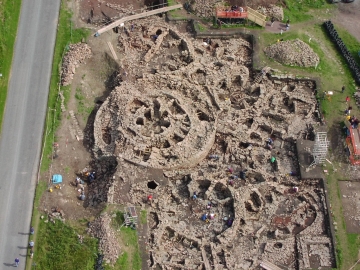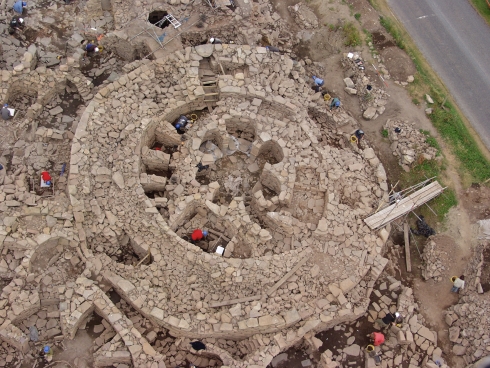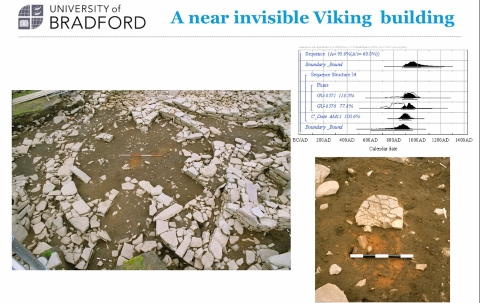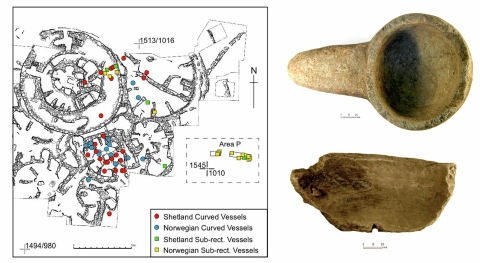Old Scatness Broch, Shetland

Author
Dr Stephen Dockrill, School of Archaeological and Forensic Sciences, University of Bradford
Region
 Dunrossness in the south mainland of Shetland
Dunrossness in the south mainland of Shetland
NGR
HU 3898 1065
Date Ranges
Neolithic to Modern (c. 20th century)
Project Summary
The Old Scatness Project explored a multi-period settlement sequence that has provided an important insight into the lives of the occupants of the site from the Early Iron Age to the 20th century. The Middle Iron Age broch and sequence of buildings surrounding the broch (Figs. 1 & 2) provided an important architectural history spanning the Middle Iron Age, the Late Iron Age or Pictish period, and beyond. Scandinavian artefacts dominated the archaeological record from the tenth century, indicating a dramatic change in culture and lifestyle (Fig. 3).

Research Themes:
Site development and chronology
The integrated absolute chronology for Old Scatness (using radiocarbon and archaeomagnetic dating) provided a framework to understand questions surrounding the site’s past inhabitants, economic development, and cultural identity.
Cultural change
The accurate dating of the structural and depositional sequence allowed factors such as cultural change to be viewed within a more precise chronological framework.
Economy – landscape/seascape interaction
An understanding of the economic exploitation both of the surrounding landscape – for arable agriculture, animal husbandry and other economic resources. The long chronological framework has allowed the study of themes such as continuity, changes in agricultural practice, and intensification in production.
The formation of archaeological deposits and sediments
The integrated investigation of deposits associated with ironworking, fuel exploitation, the identification of floor surfaces, and the formation and management of arable soils.
Manufacture, trade and contact
Evidence for craft specialisation, such as copper alloy casting and ironworking, and imported cultural material such as pottery and Roman glass, provide evidence for both production and trade and how this might have changed over time.
Power, status and social hierarchies in the Mid- and Late Iron Age
The artefact (Fig. 4) and economic evidence together with evidence derived from the use of space, and control of wealth and status social systems has contributed both to our understanding and to the reconstruction of past social systems.

Keywords
Broch Settlement, Pictish-Viking transition, Norse settlement
Bibliography
Melton, N, S J Dockrill, J M Bond, V E Turner, L D Brown, D J Bashford, J E M Cussans & R A Nicholson (eds.) 2018 Excavations at Old Scatness, Shetland, Volume 3: The Post-medieval Township. Lerwick: Shetland Heritage Publications.
Cussans, J E M, S J Dockrill, I Armit, J M Bond and J McKenzie 2017 ‘Food, gatherings and social power: Case studies in feasting and community gatherings in Iron Age Scotland’, in F Beglane (ed.) Gatherings Past and Present, 251-261. BAR Int Ser 2832.
Bond, J M and S J Dockrill 2016 ‘Viking settlement and Pictish Estates: New evidence from Orkney and Shetland’, in V E Turner, O Owen and D J Waugh (eds.) Shetland and the Viking World (Viking Congress), 7-13. Lerwick: Shetland Heritage Publications.
Bond, J M and S J Dockrill 2014 ‘The prehistoric village of Old Scatness: A research study in longevity, ecodynamics and interactions, in R Harrison and R A Maher (eds.) Human Ecodynamics in the North Atlantic: A collaborative model of humans and nature through space and time, 35-53. Lanham, Maryland: Lexington Books.
Dockrill, S J, J M Bond, V E Turner, L D Brown, D J Bashford, J E M Cussans & R A Nicholson (eds.) 2015 Excavations at Old Scatness, Shetland, Volume 2: The Broch and Iron Age Village. Lerwick: Shetland Heritage Publications.
Dockrill, S J, J M Bond, V E Turner, L D Brown, D J Bashford, J E M Cussans & R A Nicholson (eds.) 2010 Excavations at Old Scatness, Shetland Volume 1: The Pictish Village and Viking Settlement. Lerwick: Shetland Heritage Publications.
Dockrill, S J & J M Bond 2009 ‘Sustainability and resilience in prehistoric North Atlantic Britain: The importance of a mixed palaeoeconomic system,’ Journal of the North Atlantic 2: 33-50.
Guttmann, E B, I A Simpson, N Nielsen & S J Dockrill 2008 ‘Anthrosols in Iron Age Shetland: Implications for arable and economic activity,’ Geoarchaeology 23(6): 799–823.
Dockrill, S J, C M Batt & Z Outram 2006 ‘Time and place: A new chronology for the origin of the broch based on the scientific dating programme at the Old Scatness Broch, Shetland,’ Proceedings of the Society of Antiquaries of Scotland 136: 89-110.
Bond, J M, R A Nicholson & I A Simpson 2005 ‘Living off the land: Farming and fishing at Old Scatness,’ in V E Turner, R A Nicholson, S J Dockrill & J M Bond (eds.) Tall Stories? Two Millennia of Brochs, 211-220. Lerwick: Shetland Amenity Trust.
Dockrill, S J, J M Bond & C M Batt 2005 ‘Old Scatness: The first millennium AD,’ in V E Turner, R A Nicholson, S J Dockrill & J M Bond (eds.) Tall Stories? Two Millennia of Brochs, 52-65. Lerwick: Shetland Amenity Trust.
Nicholson, R A, P Barber & J M Bond 2005 ‘New evidence for the date of the introduction of the House Mouse, Mus musculus domesticus Schwarz & Schwartz and the Field Mouse Apodemus sylvaticus to Shetland. Environmental Archaeology 10: 143-151.
Turner, V E, R A Nicholson, S J Dockrill and J M Bond (eds.) 2005 Tall Stories? Broch Studies, Past Present and Future. Oxford: Oxbow.
Bond, J M, E Guttman & I A Simpson 2004 ‘Bringing in the sheaves: Farming intensification in the post-broch Iron Age’, in R Housely and G Coles (eds.) Atlantic Connections and Adaptations: Economies, environments and subsistence in lands bordering the North Atlantic, 138-145. AEA/NABO Monograph. Oxford: Oxbow Books.
Forster, A K & J M Bond 2004 ‘North Atlantic networks: Preliminary research into the trade of steatite in the Viking and Norse periods’, in R Housely & G Coles (eds.) Atlantic Connections and Adaptations: Economies, environments and subsistence in lands bordering the North Atlantic, 218-229. AEA/NABO Monograph. Oxford: Oxbow Books.
Guttmann, E B A, I A Simpson & S J Dockrill 2003 ‘Joined-up archaeology at Old Scatness, Shetland: Thin section analysis of the site and hinterland’. Environmental Archaeology 8(1): 17-31.
Rhodes, E J, C Bronk Ramsey, Z Outram, C Batt, L Willis, S Dockrill & J Bond 2003 ‘Bayesian methods applied to the interpretation of multiple OSL dates: High precision sediment ages from Old Scatness Broch excavations, Shetland Isles’. Quaternary Science Reviews 22: 1231-1244.
Sutherland, T L, A Schmidt & S J Dockrill 1998 ‘Resistivity pseudosections and their topographic correction: A report on a case study at Scatness, Shetland. Archaeological Prospection 5: 229-237.
Nicholson R A., and S J Dockrill (eds.) 1998 Old Scatness Broch, Shetland: Retrospect and Prospect. North Atlantic Biocultural Organisation Monograph No. 2, Bradford Archaeological Sciences Research 5. Bradford: Department of Archaeological Sciences.
Dockrill S J, J M Bond, J G Crummet & C P Heron 1995 ‘Scatness, Shetland: An Integrated survey of a multiperiod settlement mound’. Archaeological Prospection 2(3): 141–154.

